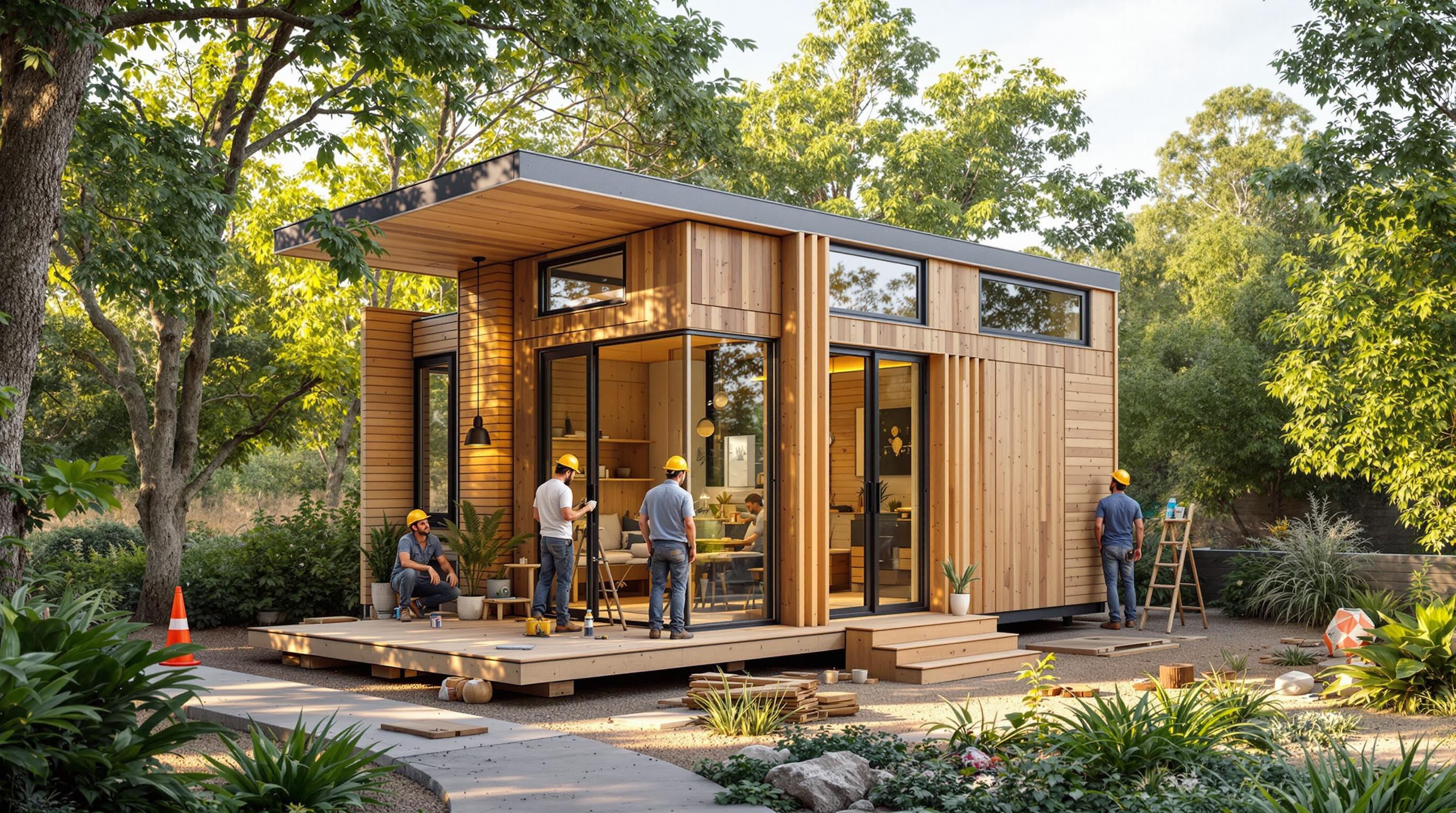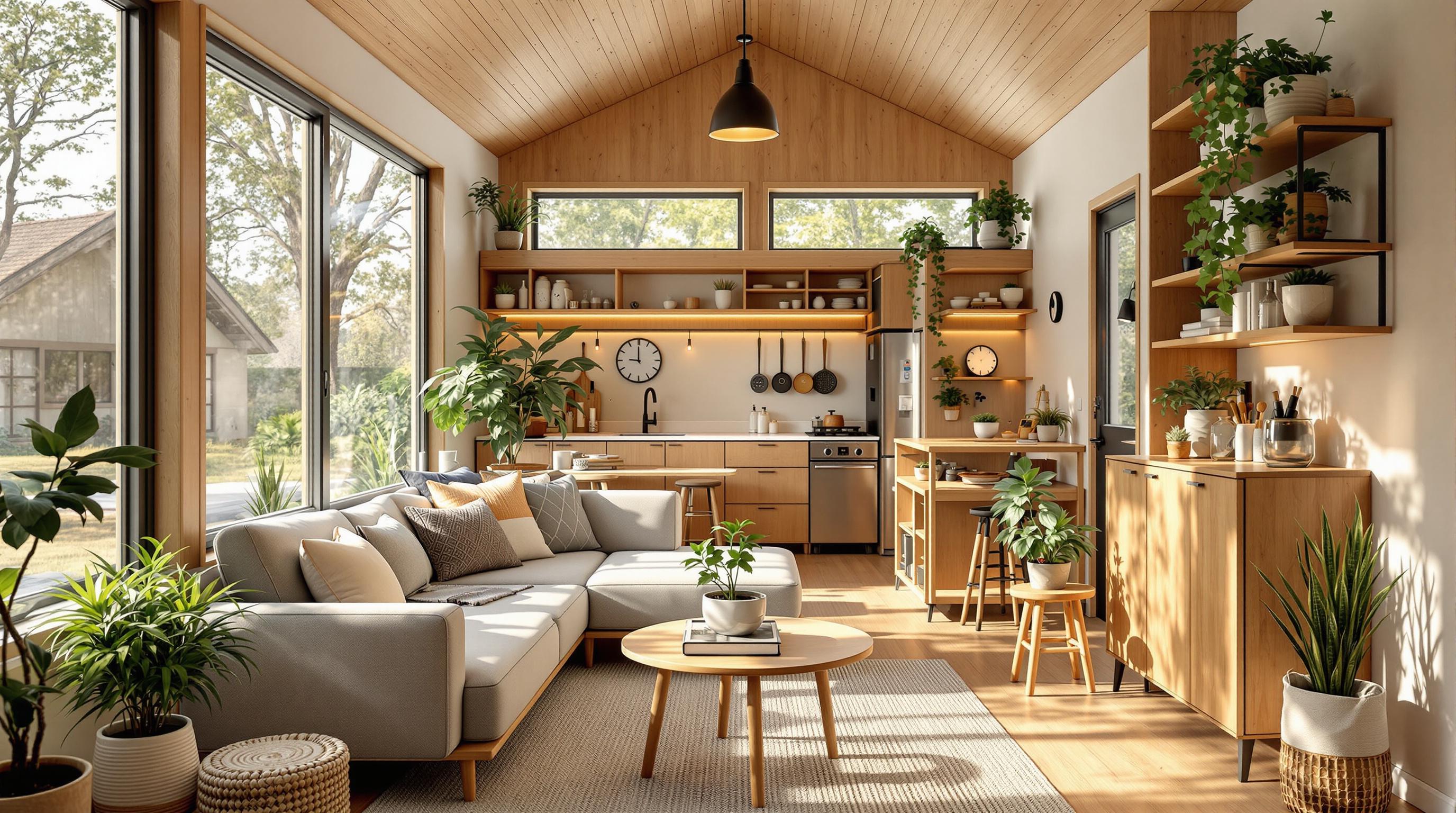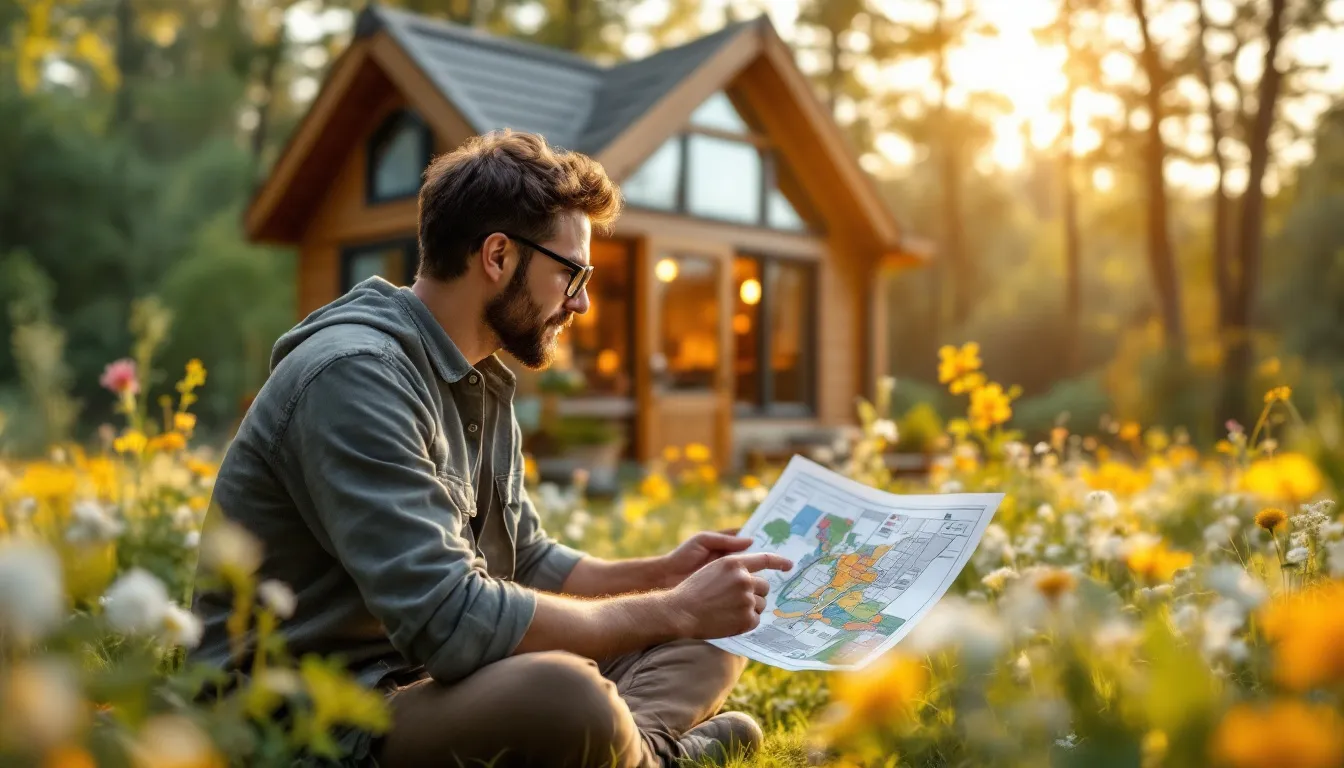Want to build a tiny house in Massachusetts? Here's what you need to know:
- Tiny houses are legal in MA since January 2020
- Must be 400 sq ft or less (not counting lofts)
- Local zoning laws still apply - check with your town
- You'll need building permits and zoning approval
- Must meet state building codes (Appendix Q)
- Some towns allow them as Accessory Dwelling Units (ADUs)
Key steps:
- Check local zoning laws
- Get building permits
- Follow MA building codes
- Find a legal place to put it
- Pass inspections
Costs range from $30,000 to $60,000+ for most builds.
Building a tiny house in MA is doable, but requires careful planning and patience. Work closely with local authorities to navigate regulations in your area.
Related video from YouTube
Types of Tiny Houses in Massachusetts
Massachusetts has specific rules for tiny houses. Let's break it down:
What's a Tiny House in Massachusetts?
Since January 2020, Massachusetts says a tiny house is 400 square feet or less, not counting lofts. This comes from the International Residential Code.
There are two main types:
1. Tiny Houses on Foundations
These are built on-site and follow local building codes, just like regular houses.
2. Tiny Houses on Wheels (THOWs)
These are often seen as RVs or mobile homes. They have different rules and usually can't be lived in full-time in residential areas.
"Most Massachusetts towns at this time still view tiny homes as not suitable for full-time living." - Kevin Vitali, Massachusetts Real Estate Agent
Some counties do things differently. Nantucket County, for example, allows tiny houses up to 500 square feet in certain areas.
Size Rules
The state says 400 square feet max, but local rules can be different:
- State-wide: 400 square feet or less (lofts don't count)
- Nantucket County: Up to 500 square feet in some spots
- Barnstable County: Has special rules for Accessory Dwelling Units (ADUs)
Always check with your local building department. They'll have the exact rules for your area.
When planning your tiny house, think about:
- Foundation: Permanent ones are more likely to be approved for living in
- How you'll use it: Full-time home? Vacation spot? This affects which rules apply
- Where it'll be: Different towns have different rules
For example, Berkshire County allows tiny houses if they meet county rules and get certified by the Building Inspector.
Getting Your Permits
Building a tiny house in Massachusetts? Get ready for a paperwork adventure. Here's what you need to know:
Building and Zoning Papers
First things first: building permits and zoning approval. Here's your game plan:
1. Talk to your local building department
Every town has its own rules. In Millis, for example, tiny houses on wheels are seen as trailers. You'll need a special permit from the Board of Appeal, and you'll have to renew it every year.
2. Show them your plans
You'll need detailed drawings of your tiny house and where it'll sit on your property.
3. Check zoning laws
Make sure your tiny house fits local zoning laws. Some places, like Nantucket, have special rules for tiny houses. They might let you build one as your main home, a secondary unit, or even a third dwelling.
4. Apply for special permits
In many cases, you'll need to ask for special permits. Be ready to make your case to the local zoning board.
"Massachusetts Municipalities have the power and freedom to enact and enforce their own Zoning Bylaws." - Ms. Bowker, Associate of a Massachusetts law firm
Utility and Land Use Permits
Got building approval? Great! Now let's tackle utilities and land use:
- Water and sewer: You'll need permits to hook up to town systems or set up your own well and septic system.
- Electrical: Get an electrical permit and be ready for inspections as you build.
- Land use: Make sure your land is zoned for homes and meets size requirements.
Here's a heads up: Some towns, like Concord, don't allow mobile homes at all. Always check local laws before you buy land or start building.
Insurance Rules
Insuring your tiny house can be tricky. Here's the scoop:
- If your tiny house is on a foundation, you might be able to insure it like a regular home.
- For tiny houses on wheels, you might need RV insurance or a special tiny home policy.
- While you're building, look into builder's risk insurance.
Insurance needs can change based on how your tiny house is classified. Some insurance companies might see it as a mobile home, others as an RV. Some even offer policies just for tiny houses.
Building a tiny house in Massachusetts is doable, but it takes planning and patience. Stick with these permit rules, and you'll be on your way to tiny living in the Bay State.
Meeting Building Codes
Building a tiny house in Massachusetts isn't just about finding a cozy spot. You need to make sure your mini-home meets all the safety and building standards. Here's what you need to know:
Massachusetts gave tiny houses the thumbs up in January 2020 by adopting Appendix Q of the International Residential Code (IRC). This was a game-changer for tiny house fans. As David Eisenberg, co-author of The Strawbale House Book, puts it:
"Appendix Q Tiny House is the first set of building standards for dwellings ever incorporated into a model code."
But what does this mean for you? Let's break it down:
Your tiny house can't be bigger than 400 square feet (not counting lofts). Living spaces and hallways need at least 6 feet 8 inches of headroom, while bathrooms and kitchens can get away with 6 feet 4 inches. Dreaming of a loft? Make sure it's at least 35 square feet with no dimension less than 5 feet.
Appendix Q isn't just about size, though. It's got specific rules to keep your tiny home safe:
- Your loft stairs need to be at least 17 inches wide. Spiral staircases are okay, but they have their own rules.
- If you're using your loft as a bedroom, you need an emergency exit window.
- Don't forget handrails and guards for stairs and lofts. Safety first!
But here's the catch: local rules can still vary. As Ms. Bowker, an associate at a Massachusetts law firm, points out:
"Massachusetts Municipalities have the power and freedom to enact and enforce their own Zoning Bylaws."
For example, in Millis, a tiny house on wheels is seen as a trailer. You'll need a special permit from the Board of Appeal, and you'll have to renew it every year.
So, what's the takeaway? Before you start building, talk to your local building inspector. They can guide you through the specific rules in your area and help make your tiny house dreams come true.
sbb-itb-2ef3f3a
Where You Can Build
Building a tiny house in Massachusetts isn't just about state laws. Local rules are key. Let's break it down:
Areas That Allow Tiny Houses
Different counties, different rules:
Nantucket County: They're tiny house pioneers. You can build up to 500 square feet in some spots. They even allow tiny houses on wheels under Zoning Bylaw 139.
Barnstable County: Tiny house friendly. They're okay with accessory dwelling units (ADUs) as long-term rentals. The catch? The owner must live in either the main house or the ADU for at least half the year.
Berkshire County: Tiny houses are welcome if they meet county rules and get the Building Inspector's nod.
Middlesex County: ADUs are fine, but the main house must be owner-occupied.
Franklin County: You can have a tiny house, but no renting it out.
But here's the thing: rules change. Always check with your local building department before you start planning.
Property Line and Lot Rules
Every town has its own playbook:
- Great Barrington lets you park a tiny house on wheels in your backyard.
- Some towns want bigger lots than you'd expect for a tiny house.
The secret? Talk to your local zoning board. They'll give you the exact numbers you need.
Parking and Community Rules
Got a tiny house on wheels? Here's where you might park it:
- RV Parks: Many welcome tiny houses on wheels.
- Campgrounds: Some let you stay long-term.
- Tiny House Communities: They're popping up all over.
Real-world examples:
1. Village Hill Cohousing in Northampton
28 homes built around shared values and eco-friendly living. Not just for tiny houses, but shows how alternative housing can work in Massachusetts.
2. Hillcrest in Rockland
A family-friendly mobile home community. Not tiny-house specific, but proves smaller homes can form a tight-knit community.
3. The Glen in the Boston Metro Area
Offers small-town vibes with city perks nearby. Another example of compact living in Massachusetts.
But heads up: zoning laws can be tough. In many residential areas, you can't just park a tiny house on wheels and call it home. Always check local rules first.
Building a tiny house in Massachusetts? It's doable, but you'll need to do your homework and be patient. Work with local authorities and stay flexible. With the right approach, you can find your perfect tiny living spot in the Bay State.
Building Standards and Checks
Building a tiny house in Massachusetts? You'll need to think big about standards. Here's what you need to know:
Building Requirements
Massachusetts has rules for tiny houses. They're not just suggestions - they're the law:
- Your tiny house must be 400 square feet or less (not counting lofts).
- Living spaces need 6 feet 8 inches of headroom. Bathrooms and kitchens? 6 feet 4 inches.
- Lofts must be at least 35 square feet. No dimension less than 5 feet.
- Sleeping lofts need an emergency escape window.
- Loft stairs? At least 17 inches wide. Spiral staircases have their own rules.
- Energy efficiency is a big deal. Expect strict standards.
David Eisenberg, co-author of The Strawbale House Book, says:
"Appendix Q Tiny House is the first set of building standards for dwellings ever incorporated into a model code."
This is huge for tiny house fans. It gives clear guidelines for safe, legal building.
Getting Your House Approved
Want that official stamp? Here's the process:
1. Plan Review
Submit your plans to the local building department. They'll check if your design meets all codes.
2. Foundation Inspection
Building on a foundation? This is your first big check.
3. Framing Inspection
Once the bones are up, it's time for the framing check. This covers walls, roof, and floor systems.
4. Plumbing and Electrical
These systems need checks before they're hidden behind walls.
5. Insulation
Before closing up walls, you'll need an insulation check.
6. Final Inspection
The big one. Everything from smoke detectors to handrails gets checked.
Each stage must pass before you move on. As Mike Luna, an industry expert, notes:
"Certification allows consumers to confidently purchase products certified to address their specific needs."
Consider using third-party agencies for inspection and certification. They can help ensure your tiny home meets all standards.
NOAH RDI has taken inspections digital:
"At NOAH RDI, these inspections are performed remotely/virtually (Remote Virtual Inspections) and digitally stored."
This modern approach can make the process smoother.
Building a tiny house in Massachusetts is a journey. Plan carefully, follow the rules, and you'll be living small in no time. Remember: in tiny houses, every inch counts - and so does every inspection.
Next Steps
You've got the basics on building a tiny house in Massachusetts. Now it's time to act. Here's what to do:
Dig into your local zoning laws. Massachusetts lets towns set their own rules. Nantucket County? They're cool with tiny houses up to 500 square feet. Most other places? They stick to 400.
Kevin Vitali, a Massachusetts Real Estate Agent, doesn't sugarcoat it:
"Your biggest hurdle is being able to find a place to put it and stay compliant with a town's building and zoning regulations."
Look into Accessory Dwelling Units (ADUs). Some towns are warming up to them. Take Barnstable County. They allow ADUs as long-term rentals. The catch? You need to live on the property at least half the year.
If zoning's too tight, think about wheels. Great Barrington lets tiny houses on wheels in backyards. RV parks or campgrounds might be an option too.
Now, let's talk money. Tiny houses in Massachusetts aren't cheap:
- Basic kits: $4,000 and up
- Average builds: $30,000 to $60,000
- Fancy models: Can top $150,000
Don't forget land, permits, and hookups. They'll add to your bill.
Here's a pro tip: Use painter's tape to mark out your floor plan on the ground. It's a simple way to see if your design works in real life.
Time for paperwork. You'll need:
- Detailed building plans
- Site plans
- Proof you're following Appendix Q rules
Each town has its own process. Expect multiple inspections as you build.
Lastly, find your people. Look for local tiny house meetups or online forums. These folks can give you tips and support as you go tiny in the Bay State.
Building a tiny house in Massachusetts isn't easy. But it's doable. Take these steps, and you're on your way to living small in a big way.
FAQs
What towns in MA allow tiny houses?
Massachusetts legalized tiny houses statewide in January 2020, but local zoning laws still matter. Here's a rundown of Western Massachusetts towns that welcome tiny houses:
- Winchester
- Lancaster
- Warwick
- Shutesbury
- Plainfield
- Pelham
- Palmer
- Montague
These towns allow detached Accessory Dwelling Units (ADUs), which can include tiny houses. But heads up - rules can change, and each town might have its own quirks.
Take Nantucket County, for example. They're cool with tiny houses up to 500 square feet in some areas. That's roomier than the state's 400 square foot definition. Over in Barnstable County, you can have ADUs as long-term rentals, but there's a catch - the owner needs to live on the property for at least half the year.
Here's the kicker: even in these tiny-house-friendly towns, you've got to play by the rules. Local building codes and zoning regulations are still a thing.
Kevin Vitali, a Massachusetts Real Estate Agent, puts it straight:
"Your biggest hurdle is being able to find a place to put it and stay compliant with a town's building and zoning regulations."
So, what's the move? Before you start dreaming up your tiny house, chat with the local building department and zoning board. They'll give you the lowdown on the latest rules and what permits you'll need. It's all about location, location, location - and making sure you're on the right side of the law.



